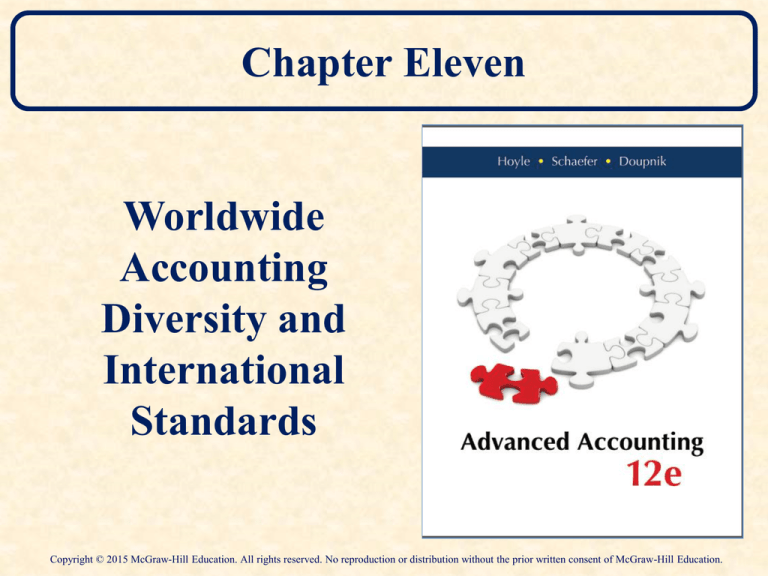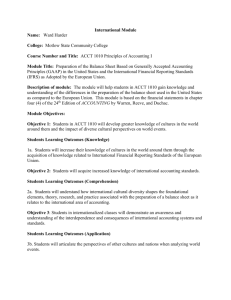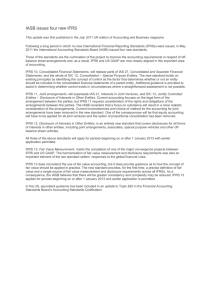
Chapter Eleven
Worldwide
Accounting
Diversity and
International
Standards
Copyright © 2015 McGraw-Hill Education. All rights reserved. No reproduction or distribution without the prior written consent of McGraw-Hill Education.
International Accounting Diversity
Chinese companies
use the direct method
in preparing the
statement of cash
flows.
Companies in
Germany are
allowed to report
assets on the
balance sheet at
revalued amounts.
Most companies in
the United States
and Europe use the
indirect method.
11-2
Learning Objective 11-1
Explain the major factors
influencing the international
development of accounting
systems.
11-3
Reasons for Accounting Diversity
Legal
System
Taxation
All these interact!!!
Political
and
Economic
Ties
Culture
Inflation
Financing
Systems
11-4
Reasons for Accounting DiversityLegal System
Common Law
Found primarily in English-speaking
countries, where courts establish
precedent.
Accounting profession plays a large
role in standard setting and tends to
be independent.
Standards tend to be detailed.
11-5
Reasons for Accounting DiversityLegal System
Roman (Codified) Law
Based on statute rather than precedent.
Laws govern business enterprises.
Accounting profession tends to have little influence
on standard setting, is frequently an adjunct of the
legal system.
Accounting law tends to be lacking in detail.
11-6
Reasons for Accounting DiversityFinancing Systems
Major providers of financing:
Family members
Banks
Focus on solvency and liquidity (balance sheet
emphasis)
Governments
Shareholders
Focus on profitability (income statement emphasis)
Other creditors
11-7
Reasons for Accounting DiversityOther Issues
Taxation
Financial statements are the basis for taxation in some countries.
Others adjust financial statements for tax purposes, and submit
separate reports to stockholders’.
Inflation
High inflation tends to render historical cost useless.
High inflation rates force adoption of accounting rules that adjust
historical costs to current or market value.
Creditors tend to suffer under highly inflationary economies.
11-8
Reasons for Accounting DiversityPolitical and Economic Ties
Accounting methods are readily conveyed from one country
to another, either by trade or conquest:
– Britain’s former colonies, such as Australia and
Canada, tend toward “common law” systems
– Former French colonies, such as Senegal and Congo,
base accounting standards on “codified law”
– Economic ties with the US have impacted accounting in
Canada, Mexico and Israel
11-9
Reasons for Accounting DiversityCulture
Societal values found within cultures:
Individualism
Uncertainty Avoidance
Power Distance
Masculinity
These values are thought to shape legal systems and capital
markets.
They influence accounting values shared by members of the
accounting subculture, which influences the nature of the
accounting system.
11-10
Gray’s Framework for the Development of
Accounting Systems Internationally
Cultural Dimensions
Individualism
Uncertainty Avoidance
Power Distance
Masculinity
Institutional Consequences
Legal system
Corporate Ownership
Capital Markets
Professional Associations
Education & Religion
Accounting Values
Professionalism
Uniformity
Conservatism
Secrecy
Accounting Systems
Authority
Enforcement
Measurement
Disclosure
11-11
Nobes’ Model of the Reasons for
International Accounting Diversity
Nobes’ simplified model has two explanatory factors:
(1) national culture, including institutional structures,
(2) the nature of a country’s financing system divided into
two classes.
Class A (Strong equity-outsider financing system)
Less conservative
Greater disclosure
Financial and tax accounting separate
Class B (Weak equity-outsider financing system)
More conservative
Less extensive disclosure
Financial reporting follows tax rules
11-12
Learning Objective 11-2
Understand the problems
created by differences in
accounting standards across
countries and the reasons to
develop a set of internationally
accepted accounting standards.
11-13
Problems Caused By Diverse
Accounting Standards
1. Subs use local standards for financial statements. The
parent must adjust the subs’ statements to GAAP.
Statements must be re-stated in common standards.
2. To access foreign capital markets, costly measures must
be taken to prepare financial statements that comply
with local standards.
3. Financial statements from different countries are
simply not comparable. Accounting rules differ from
country to country.
11-14
International Harmonization
Harmonization: Reducing differences in accounting
practices across countries.
Harmonization efforts have been ongoing for decades,
and originally the International Accounting Standards
Committee (IASC) led the movement.
In 1987, the International Organization of Securities
Commissions (IOSCO) joined the effort.
Since 2001, the process has been led by the
International Accounting Standards Board (IASB)
11-15
Learning Objective 11-3
List the authoritative
pronouncements that constitute
International Financial
Reporting Standards (IFRS).
11-16
International Accounting Standards
Committee- IASC
International Accounting Standards
committee (IASC) established in 1973.
IASB superseded IASC in April 2001.
16-member board
at least 13 full-time
The IASB has sole responsibility for
establishing IFRSs (“IASB GAAP”)
IASB has no enforcement authority!!
11-17
International Accounting Standards Board
(IASB)
All of the 41 IASs issued by the IASC were
adopted by the IASB.
28 are currently in effect.
New standards are called “International
Financial Reporting Standards” (IFRSs).
As of January 2013, 13 IFRSs have been
issued.
11-18
Learning Objective 11-4
Describe the ways and the
extent to which IFRS are used
around the world.
11-19
International Financial Reporting
Standards (IFRSs)
Countries can elect to use IFRS by:
(1) adopting IFRS as its national GAAP
(2) requiring domestic listed companies to use
IFRS in preparing their consolidated
financial statements
(3) allowing domestic listed companies to use
IFRS
(4) requiring or allow foreign companies listed
on a domestic stock exchange to use IFRS.
11-20
International Financial Reporting
Standards (IFRSs)
Of the 153 countries using IFRS as of June 2012:
(1) 92 require all domestic listed companies to
use IFRS in preparing their consolidated
financial statements.
(2) All publicly traded companies in the EU are
required to use IFRS.
(3) Two significant exceptions – China and the
U.S.
11-21
Learning Objective 11-5
Describe the FASB–IASB
convergence process and the
SEC recognition of IFRS.
11-22
Norwalk Agreement:
FASB-IASB Convergence
In Norwalk, Connecticut, FASB and IASB held a
joint meeting in September 2002.
The “Norwalk Agreement” states that the two
bodies will “use their best efforts” to:
1. Make existing financial reporting standards
compatible “as soon as is practicable” and
2. Coordinate efforts to “ensure that once
achieved, compatibility is maintained”
11-23
Norwalk Agreement:
FASB-IASB Convergence
2006- Memorandum of Understanding (MoU)
FASB and IASB agreed that trying to eliminate
differences between standards and create identical
standards, even if jointly developed, is not realistic.
Instead, they agreed that standards in need of
improvement should be replaced with new jointly
developed standards.
The idea behind convergence is to have similar, but
not necessarily identical standards.
11-24
FASB-IASB Convergence
As of January 2013, the FASB‐IASB convergence process had
resulted in changes made to U.S. GAAP, IFRS, or both:
•
•
•
•
•
•
•
•
Business combinations
Consolidated financial statements
Non‐controlling interests
Acquired in‐process research costs
Non‐monetary asset exchanges
Share‐based payment
Accounting changes
Presentation of (OCI)
∙ Borrowing costs
∙ Derecognition
∙ Post‐employment benefits
∙ Fair value option
∙ Joint ventures
∙ Fair value measurement
∙ Segment reporting
∙ Inventory accounting
11-25
FASB-IASB Convergence
As part of its technical agenda at the beginning of 2013,
the FASB listed the following on‐going joint convergence
projects with either an Exposure Draft or final standard
expected to be issued in 2013:
• Leases
• Insurance contracts
• Financial instruments
• Revenue recognition
11-26
IFRS Roadmap
IFRS Roadmap:
In November 2008, SEC issued a proposed
rule that set milestones toward the use of
IFRS by U.S. public companies by 2014.
In February 2010, SEC pushed that date
back to “approximately 2015 or 2016.”
11-27
IFRS Framework
In May 2011, the SEC published a suggested framework for an
“endorsement process” incorporating IFRS into U.S. GAAP.
The two components of the framework are:
(1) FASB continues to participate in the process of
developing new IFRSs and incorporates those standards
into U.S. GAAP by means of an endorsement process.
(2) The FASB would incorporate existing IFRSs into U.S.
GAAP over a defined period of time, e.g., five to seven
years, with a focus on minimizing transition costs for U.S.
companies.
11-28
IFRS Framework
This approach would:
•
maintain U.S. GAAP, which could continue to be
used by both public and nonpublic companies.
•
achieve the objective of having a single set of highquality, globally accepted accounting standards.
•
retain the FASB’s authority for establishing
financial reporting standards in the United States,
and provide the flexibility to modify the
requirements of IFRS.
11-29
IFRS Framework
Modifications could include:
•
Requiring additional disclosures beyond what is
required by an IFRS.
•
Prescribing which of two or more alternative
accounting treatments allowed by IFRS should be
followed by U.S. issuers.
•
Promulgating standards on issues not specifically
addressed in IFRS.
11-30
First-time Adoption of IFRS
Large US publicly-traded companies may be required
to adopt IFRS someday.
What does this mean?
The company would prepare an opening balance sheet
at the “transition date” and present re-stated
comparative statements also prepared under IFRS.
11-31
First-time Adoption of IFRS
Steps To prepare opening IFRS balance sheet:
1. Determine the applicable IFRS.
2. Recognize assets and liabilities not recognized
under GAAP and derecognize those not allowed
under IFRS.
3. Measure the balance sheet accounts under IFRS at
the balance sheet date.
4. Reclassify certain assets and liabilities in
accordance with IFRS.
5. Comply with disclosure and presentation
requirements.
11-32
IFRS Accounting Policy Hierarchy
IAS 8, Accounting Policies, Changes in Accounting
Estimates and Errors, establishes the hierarchy that
firms must follow when dealing with an accounting
issue:
1. Apply specifically relevant standards (IASs, IFRSs,
or Interpretations).
2. Refer to other IASB standards.
3. Refer to the IASB Framework for guidance.
4. Consider the most recent pronouncements of other
standard-setting bodies
11-33
IFRS Accounting Policy Hierarchy
In establishing accounting policies to be followed
under IFRS, the two extreme approaches that
companies can follow are:
1. Minimize change. Under this approach a company
would adopt accounting policies consistent with IFRS
that are most consistent with current accounting
policies.
2. Fresh start. Under this approach a company would
ignore current accounting policies and adopt
accounting policies consistent with the IFRS that best
reflect economic reality.
11-34
Learning Objective 11-6
Recognize acceptable accounting
treatments under IFRS and
identify key differences between
IFRS and U.S. GAAP.
11-35
Current Differences Between IFRSs and
US GAAP
Recognition:
If recognized, how? When?
Presentation:
Principles? Financial
Statement Components?
Disclosure:
Measurement:
If allowed, How?
How is cost determined?
Discontinued
Operations
Extraordinary
Items
Inventory
Fixed
Assets
11-36
Current Differences Between IFRSs and
US GAAP
There are differences in nearly every area of financial
accounting including:
Inventory -- cost flow and write-offs
PP&E-- measurement and subsequent costs
Asset Impairment – measurement and subsequent
reversals
Construction contracts – recognition method
R&D – capitalization vs expense
Operating Leases – gain recognition
Pensions – vested benefits
11-37
Current Differences Between IFRSs and
US GAAP
Continued…
Income taxes – deferred tax assets
Classification of deferred taxes
Consolidated financial statements –
Parent vs. Subsidiary
Interim reporting –
Discrete vs. integral
Presentation of “extraordinary” items
Definition of a “discontinued operation”
Statement of Cash Flows –
Interest classification
11-38
IAS 1: Presentation of Financial Statements
IFRSs contain this single standard governing the
presentation of financial statements. There is no US
GAAP equivalent.
Key guidance elements:
– Purpose
– Overriding principle of fair presentation
– Basic principles and assumptions
– Components of financial statements
– Structure and content of financial statements
11-39
Presentation of Financial Statements
IFRS COMPANY Income Statement
11-40
Learning Objective 11-7
Determine the impact that
specific differences between
IFRS and U.S. GAAP have on
the measurement of income
and stockholders’ equity.
11-41
U.S. GAAP Reconciliations
Interest Capitalization
Business Combinations
Purchase vs. Pooling Methods
Goodwill
Amortization vs. Impairment
Leases
Revaluation of Fixed Assets
Fixed Asset Impairment Losses
11-42
U.S. GAAP Reconciliations
IASB: PrinciplesBased
Provide general
principles with
limited guidance.
Requires greater
professional
judgment.
FASB: Rules-Based
Provide detailed
guidance.
May encourage
mindset of looking
for loop-holes.
11-43
U.S. GAAP Reconciliations
Translation of IFRS into other languages
IFRS are drafted in English, then translated into other
languages. Time has already proven that some terms
(“probable” or “remote”) are not translating with the
same meaning.
The impact of Culture
Using professional judgment under IFRS, an accountant in
one country may reach a different conclusion than an
accountant in another part of the world.
11-44




